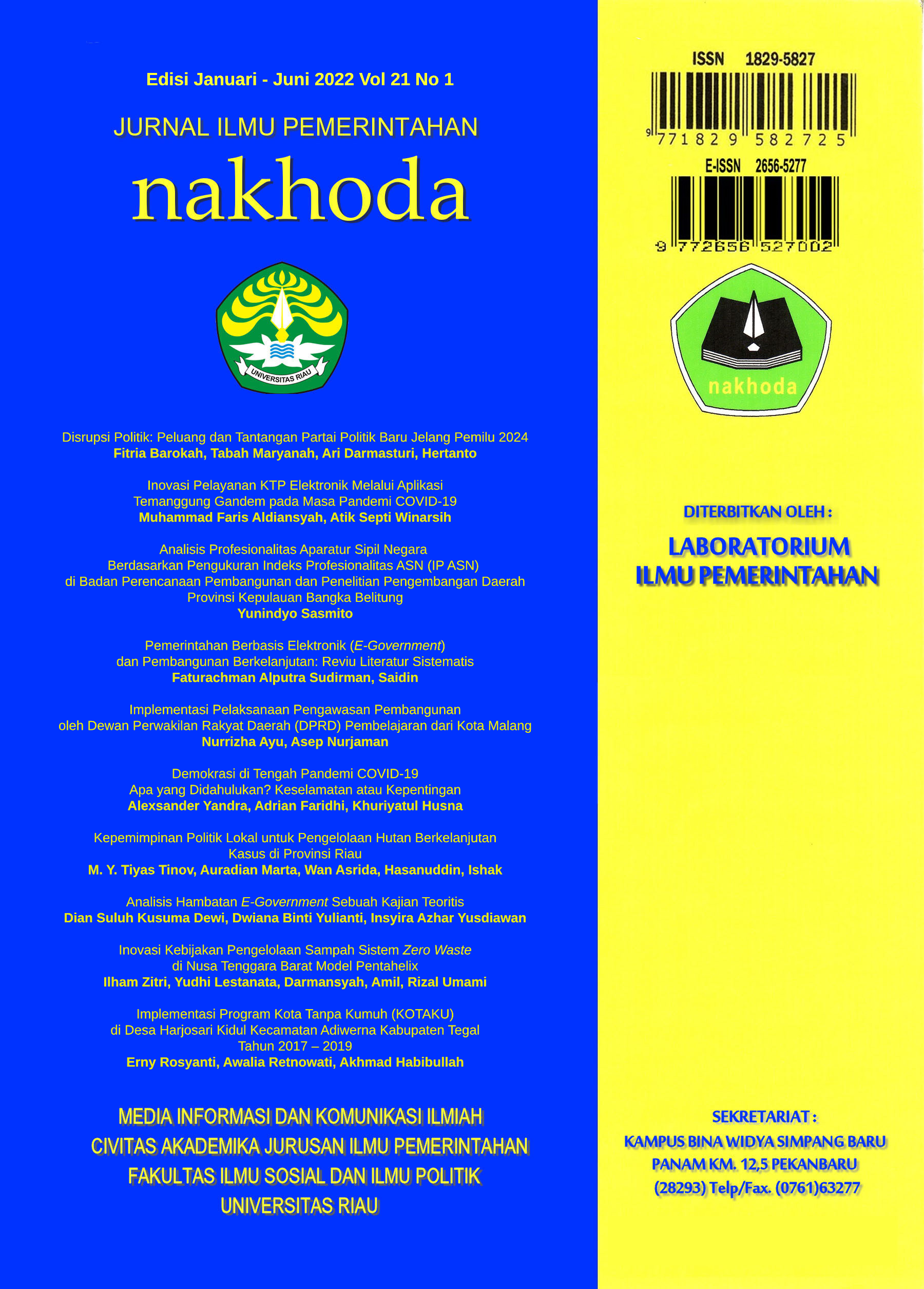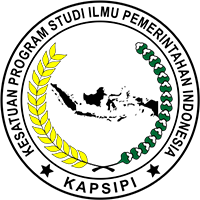An Analysis of Barriers to E-government
A Theoretical Study
DOI:
https://doi.org/10.35967/njip.v21i1.336Keywords:
Analysis, Barriers, E-GovernmentAbstract
The existence of the Internet has a tremendous influence on human life in all fields. As a manifestation of improving services to the community, government agencies also use the Internet in providing services which are then known as e-government. E-government is designed as an internet-based service method that is able to provide fast, practical, and efficient services while providing transparency to the public. This article describes the implementation of e-government in government agencies with the aim of analyzing the obstacles found in the implementation of e-government. This article is library research where data collection is done by reviewing and exploring references in the form of articles, journals, books, magazines or other literature related to the topic under study. Data analysis was performed using Nvivo 12 plus. The results of this study indicate that there are three main obstacles in implementing e-government, namely: 1) understanding organizational culture; 2) linking political organization to the barriers of e-government, and 3) technological infrastructure barriers. Knowing these obstacles is expected to be an evaluation material for the government to better prepare for the implementation of e-government.
Downloads
References
Aldiansyah, M. F., & Winarsih, A. S. (2022). Inovasi Pelayanan KTP Elektronik Melalui Aplikasi Temanggung Gandem pada Masa Pandemi COVID-19. Nakhoda: Jurnal Ilmu Pemerintahan, 21(1), 14–30. https://doi.org/10.35967/njip.v21i1.272
Al-Hujran, O., Al-Debei, M. M., Chatfield, A., & Migdadi, M. (2015). The imperative of influencing citizen attitude toward e-government adoption and use. Computers in Human Behavior, 53, 189–203. https://doi.org/10.1016/j.chb.2015.06.025
Alomari, M. K., Sandhu, K., & Woods, P. (2014). Exploring citizen perceptions of barriers to e-government adoption in a developing country. Transforming Government: People, Process and Policy, 8(1), 131–150. https://doi.org/10.1108/TG-05-2013-0013
Alshehri, M. A., & Drew, S. (2010). Implementation of e-Government: Advantages and Challenges. International Conference E-Activity and Leading Technologies 2010, 79–86.
Angelopoulos, S., Kitsios, F., Kofakis, P., & Papadopoulos, T. (2010a). Emerging barriers in e-government implementation. Lecture Notes in Computer Science (Including Subseries Lecture Notes in Artificial Intelligence and Lecture Notes in Bioinformatics), 6228 LNCS, 216–225. https://doi.org/10.1007/978-3-642-14799-9_19
Angelopoulos, S., Kitsios, F., Kofakis, P., & Papadopoulos, T. (2010b). Emerging barriers in e-government implementation. Lecture Notes in Computer Science (Including Subseries Lecture Notes in Artificial Intelligence and Lecture Notes in Bioinformatics), 6228 LNCS, 216–225. https://doi.org/10.1007/978-3-642-14799-9_19
Ariansyah, K., Sirait, E. R. E., Nugroho, B. A., & Suryanegara, M. (2021). Drivers of and barriers to e-commerce adoption in Indonesia: Individuals’ perspectives and the implications. Telecommunications Policy, 45(8), 102219. https://doi.org/10.1016/j.telpol.2021.102219
Arief, A., Ayub Wahab, I. H., & Muhammad, M. (2021). Barriers and Challenges of e-Government Services: A Systematic Literature Review and Meta-Analyses. IOP Conference Series: Materials Science and Engineering, 1125(1), 012027. https://doi.org/10.1088/1757-899x/1125/1/012027
Avotra, A. A. R. N., Chengang, Y., Sandra Marcelline, T. R., Asad, A., & Yingfei, Y. (2021). Examining the Impact of E-Government on Corporate Social Responsibility Performance: The Mediating Effect of Mandatory Corporate Social Responsibility Policy, Corruption, and Information and Communication Technologies Development During the COVID era. Frontiers in Psychology, 12(October), 1–14. https://doi.org/10.3389/fpsyg.2021.737100
Cahyadi, A. (2003). E-Government: Konsep Dan Permasalahan. Journal The WINNERS, 1–12.
Cross, W., & Gauja, A. (2014). Australian Journal of Political Science Designing candidate selection methods?: Exploring diversity in Australian political parties. February 2015, 37–41. https://doi.org/10.1080/10361146.2013.873769
Dash, S., & Pani, S. K. (2016). E-Governance Paradigm Using Cloud Infrastructure: Benefits and Challenges. Procedia Computer Science, 85(Cms), 843–855. https://doi.org/10.1016/j.procs.2016.05.274
Denison, D. R. (1989). Organizational Culture and Effectiveness. Encyclopedia of Management Theory, 168–173. https://doi.org/10.4135/9781452276090.n190
Dias, G. P. (2020a). Determinants of e-government implementation at the local level: an empirical model. Online Information Review, 44(7), 1307–1326. https://doi.org/10.1108/OIR-04-2020-0148
Eynon, R., & Dutton, W. H. (2007). Barriers to networked governments: Evidence from Europe. Prometheus (United Kingdom), 25(3), 225–242. https://doi.org/10.1080/08109020701531361
Gilbert, D., Balestrini, P., & Littleboy, D. (2004). Barriers and benefits in the adoption of e-government. International Journal of Public Sector Management, 17(4), 286–301. https://doi.org/10.1108/09513550410539794
Glyptis, L., Christofi, M., Vrontis, D., Giudice, M. del, Dimitriou, S., & Michael, P. (2020). E-Government implementation challenges in small countries: The project manager’s perspective. Technological Forecasting and Social Change, 152(December 2019). https://doi.org/10.1016/j.techfore.2019.119880
Harakan, A., Luhur Prianto, A., & Khaerah, N. (2019). Strategi Pemerintah Daerah Dalam Pengembangan Pelayanan Berbasis E-Government Di Kabupaten Muna. NAKHODA: JURNAL ILMU PEMERINTAHAN, 18(2), 64–78. https://doi.org/10.35967/jipn
Hariyanti, N. T., & Wirapraja, A. (2018). Pengaruh Influencer Marketing Sebagai Strategi Pemasaran Digital Era Moderen (Sebuah Studi Literatur). Jurnal Eksekutif, 15(1), 133–146.
Harrison, T. M., Guerrero, S., Burke, G. B., Cook, M., Cresswell, A., Helbig, N., Hrdinova, J., & Pardo, T. (2012a). Open government and e-government: Democratic challenges from a public value perspective. Information Polity, 17(2), 83–97. https://doi.org/10.3233/IP-2012-0269
Kabbar, E. F. (2021a). A comparative analysis of the e-government development index (EGDI). 14th International Conference on ICT, Society, and Human Beings, ICT 2021, 18th International Conference on Web Based Communities and Social Media, WBC 2021 and 13th International Conference on e-Health, EH 2021 - Held at the 15th Multi-Conference on Comp, 23–29. https://doi.org/10.33965/ict2021_202106l003
Kabbar, E. F. (2021b). A comparative analysis of the e-government development index (EGDI). 14th International Conference on ICT, Society, and Human Beings, ICT 2021, 18th International Conference on Web Based Communities and Social Media, WBC 2021 and 13th International Conference on e-Health, EH 2021 - Held at the 15th Multi-Conference on Comp, 23–29. https://doi.org/10.33965/ict2021_202106l003
Karunasena, K., & Deng, H. (2012). Critical factors for evaluating the public value of e-government in Sri Lanka. Government Information Quarterly, 29(1), 76–84. https://doi.org/10.1016/j.giq.2011.04.005
Khadaroo, I., Wong, M. S., & Abdullah, A. (2013). Barriers in local e-government partnership: Evidence from Malaysia. Electronic Government, 10(1), 19–33. https://doi.org/10.1504/EG.2013.051274
Lnes, S., Ubacht, J., & Janssen, M. (2017). Blockchain in government: Benefits and implications of distributed ledger technology for information sharing. Government Information Quarterly, 34(3), 355–364. https://doi.org/10.1016/j.giq.2017.09.007
Manda, M. I., & Backhouse, J. (2016). An analysis of the barriers to e-government integration, interoperability and information sharing in developing countries: a systematic review of literature. Proceedings of ACIST, 5–6 July 2016, Accra, Ghana, September, 43–54.
Meijer, A. (2015). E-governance innovation: Barriers and strategies. Government Information Quarterly, 32(2), 198–206. https://doi.org/10.1016/j.giq.2015.01.001
Melin, U., & Wihlborg, E. (2018a). Balanced and integrated e-government implementation – exploring the crossroad of public policy-making and information systems project management processes. Transforming Government: People, Process and Policy, 12(2), 191–208. https://doi.org/10.1108/TG-12-2017-0080
Metaxiotis, K., & Psarras, J. (2004). E-government: new concept, big challenge, success stories. Electronic Government, 1(2), 141–151. https://doi.org/10.1504/EG.2004.005174
Mujali Al-rawahna, A. S., Chen, S.-C., & Hung, C.-W. (2018). The Barriers of E-Government Success?: An Empirical Study from Jordan. International Journal of Managing Public Sector Information and Communication Technologies, 9(2), 01–18. https://doi.org/10.5121/ijmpict.2018.9201
Mulyanto, D. H. (2019). The Quality In Electronic Services Jogja City Government: In Case E-Ktp. NAKHODA; JURNAL ILMU PEMERINTAHAN, 18(2), 104–116. https://doi.org/10.35967/jipn
Mumford, M. D., Scott, G. M., Gaddis, B., & Strange, J. M. (2002). Leading creative people: Orchestrating expertise and relationships. Leadership Quarterly, 13(6), 705–750. https://doi.org/10.1016/S1048-9843(02)00158-3
Musfikar, R. (2018). Kendala Dalam Implementasi E-Government Pada Pemerintah Kabupaten Pidie. Cyberspace: Jurnal Pendidikan Teknologi Informasi, 2(1), 48. https://doi.org/10.22373/cs.v2i1.2746
Nurdin, N., Stockdale, R., & Scheepers, H. (2011). Understanding organizational barriers influencing local electronic government adoption and implementation: The electronic government implementation framework. Journal of Theoretical and Applied Electronic Commerce Research, 6(3), 13–27. https://doi.org/10.4067/S0718-18762011000300003
Othman, M. H., Razali, R., & Nasrudin, M. F. (2020). Key Factors for E-Government towards Sustainable Development Goals. International Journal of Advanced Science and Technology, 29(6s), 2864–2876.
Ozkan, B. C. (2004). Using NVivo to Analyze Qualitative Classroom Data on Constructivist Learning Environments Using NVivo to Analyze Qualitative Classroom Data on Constructivist. 9(4), 589–603.
Petter, S., Delone, W., & McLean, E. R. (2013). Information systems success: The quest for the independent variables. Journal of Management Information Systems, 29(4), 7–62. https://doi.org/10.2753/MIS0742-1222290401
Puspitasari, D. A., & Kurniawan, T. (2021a). Mitigasi Kegagalan Guna Mewujudkan Keberlanjutan E-Government. Gorontalo Journal of Government and Political Studies, 4(1), 104. https://doi.org/10.32662/gjgops.v4i1.1256
Puspitasari, D. A., & Kurniawan, T. (2021b). Mitigasi Kegagalan Guna Mewujudkan Keberlanjutan E-Government. Gorontalo Journal of Government and Political Studies, 4(1), 104. https://doi.org/10.32662/gjgops.v4i1.1256
Rana, N. P., Dwivedi, Y. K., & Williams, M. D. (2013a). Analysing challenges, barriers and CSF of egov adoption. Transforming Government: People, Process and Policy, 7(2), 177–198. https://doi.org/10.1108/17506161311325350
Sabani, A., Deng, H., & Thai, V. (2019). Evaluating the development of E-government in Indonesia. ACM International Conference Proceeding Series, 254–258. https://doi.org/10.1145/3305160.3305191
Saleh, S., Nakshabandi, O. A., Zeebaree, M., Ismael, G. Y., & Aqel, M. (2021). Organizational barriers which are facing electronic government implementation: The electronic government implementation framework. Estudios de Economia Aplicada, 39(7). https://doi.org/10.25115/eea.v39i7.5231
Sanchez, a., Koh, C., Kappelman, L., & Prybutok, V. (2003a). The relationship between IT for communication and e-government barriers. AMCIS 2003 Proceedings, 835–844.
Savoldelli, A., Codagnone, C., & Misuraca, G. (2014). Understanding the e-government paradox: Learning from literature and practice on barriers to adoption. Government Information Quarterly, 31(SUPPL.1), S63–S71. https://doi.org/10.1016/j.giq.2014.01.008
Schwester, R. (2009). Examining the Barriers to e-Government Adoption. Electronic Journal of E-Government, 7(1), 113–122.
Setiawan, R. E. B., Nurmandi, A., Muallidin, I., Kurniawan, D., & Salahudin. (2022). Technology for Governance: Comparison of Disaster Information Mitigation of COVID-19 in Jakarta and West Java. In Lecture Notes in Networks and Systems (Vol. 319, Issue September 2021). Springer International Publishing. https://doi.org/10.1007/978-3-030-85540-6_17
Sosiawan, E. A. (2008). Tantangan Dan Hambatan Dalam Implementasi E-Government Di Indonesia. Seminar Nasional Informatika, 2008(semnasIF), 99–108.
Sudirman, F. A., & Saidin, S. (2022). Pemerintahan Berbasis Elektronik (E-Government) dan Pembangunan Berkelanjutan: Reviu Literatur Sistematis. Nakhoda: Jurnal Ilmu Pemerintahan, 21(1), 44–58. https://doi.org/10.35967/njip.v21i1.269
Tri, M., & Farikhah, R. (2019). Implementation Of Smart Governance Concept Policy In Bantul Regency. NAKHODA: JURNAL ILMU PEMERINTAHAN, 18(2), 129–137. https://doi.org/10.35967/jipn
Wahyudin, Y., & Rahayu, D. N. (2020). Analisis Metode Pengembangan Sistem Informasi Berbasis Website: A Literatur Review. Jurnal Interkom: Jurnal Publikasi Ilmiah Bidang Teknologi Informasi Dan Komunikasi, 15(3), 26–40. https://doi.org/10.35969/interkom.v15i3.74
Zuiderwijk, A., Janssen, M., Choenni, S., Meijer, R., & Alibaks, R. S. (2012). Socio-technical Impediments of Open Data. Electronic Journal of E-Government, 10(2), 156–172. https://doi.org/10.1641/b570402?ref=search-gateway:885882d1830675b0f27af0760faeaef8
Downloads
Published
How to Cite
Issue
Section
License
Copyright (c) 2022 Authos(s)

This work is licensed under a Creative Commons Attribution-NonCommercial-ShareAlike 4.0 International License.





